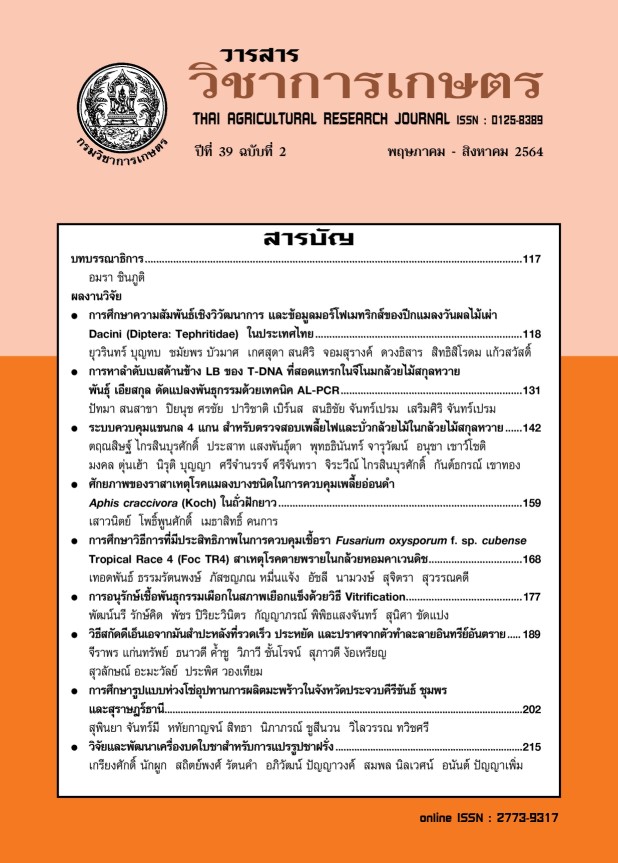การศึกษารูปแบบห่วงโซ่อุปทานการผลิตมะพร้าวในจังหวัดประจวบคีรีขันธ์ ชุมพร และสุราษฎร์ธานี
DOI:
https://doi.org/10.14456/thaidoa-agres.2021.17คำสำคัญ:
มะพร้าว, ห่วงโซ่อุปทานบทคัดย่อ
การศึกษาครั้งนี้มีวัตถุประสงค์ เพื่อศึกษารูปแบบห่วงโช่อุปทานการผลิตมะพร้าวในพื้นที่ จ.ประจวบคีรีขันธ์ ชุมพร และสุราษฎร์ธานี โดยรวบรวมข้อมูลจากการสัมภาษณ์เกษตรกรผู้ปลูกมะพร้าว ผู้รับซื้อมะพร้าว และร้านค้าจำหน่ายกะทิสดในพื้นที่ 3 จังหวัด ดังกล่าว ระหว่างเดือนตุลาคม 2561 - กันยายน 2562 พบว่า รูปแบบห่วงโซ่การผลิตมะพร้าวของทั้ง 3 จังหวัด มีรูปแบบเดียวกัน โดยมีผู้เกี่ยวข้อง 4 ระดับ คือ เกษตรกร (ต้นน้ำ) ผู้รวบรวมผลผลิต (กลางน้ำ) ผู้แปรรูป (กลางน้ำ) และผู้บริโภค (ปลายน้ำ) โดยเริ่มจากเกษตรกรซึ่งส่วนใหญ่มีอายุมากกว่า 60 ปี การศึกษาระดับประถมศึกษา มีความรู้การผลิตมะพร้าวจากคนในครอบครัวจากรุ่นสู่รุ่น มีพื้นที่ปลูกเฉลี่ย 8 - 14 ไร่ พื้นที่ปลูกส่วนใหญ่เป็นที่ราบ ดินทรายปนร่วน และเหนียวปนทราย พันธุ์มะพร้าวที่ปลูกเป็นพันธุ์ไทยต้นสูง มีอายุเฉลี่ยมากกว่า 50 ปี นอกจากนี้ เกษตรกรส่วนใหญ่มีการจัดการสวนที่ไม่เหมาะสม การดูแลรักษาใส่ปุ๋ยเคมีสูตร 15-15-15 อัตรา 1 - 2 กก./ต้น/ปี เฉลี่ยปีละ 1 ครั้ง ให้ผลผลิตเฉลี่ยน้อยกว่า 1,000 ลูก/ไร่/ปี ในส่วนของผู้รวบรวมผลผลิตหรือโรงรับซื้อ ทำหน้าที่รับซื้อผลมะพร้าวจากสวนเกษตรกรมารวบรวมและจัดการผลผลิตในรูปแบบต่าง ๆ ขึ้นอยู่กับแต่ละพื้นที่ ได้แก่ ปอกเปลือกชั้นนอก ปอกเปลือกเหลือแต่จุก มะพร้าวขาว มะพร้าวแห้ง และกะทิสด ก่อนส่งจำหน่ายให้ลูกค้าต่อไป มะพร้าวที่ส่งไปยังโรงงานแปรรูปส่วนใหญ่จะมีปัญหาเรื่อง ราคา การคัดคุณภาพ และการกำหนดปริมาณ ซึ่งถูกกำหนดโดยโรงงาน ในขณะที่การส่งไปยังภูมิภาคต่าง ๆ เพื่อจำหน่ายในรูปกะทิสด ผู้รวบรวมสามารถกำหนดราคาที่อ้างอิงจากราคาตลาดได้เอง ดังนั้น ควรหาแนวทางในการเพิ่มสัดส่วนผลผลิตมะพร้าวไปในเส้นทางดังกล่าว สำหรับผู้แปรรูป ได้แก่ ร้านค้าจำหน่ายกะทิสด โรงงานทำเนื้อมะพร้าว โรงงานแปรรูปกะทิกล่อง โรงงานสกัดน้ำมัน และเกษตรกรผู้แปรรูปจากมะพร้าว โดยเกษตรกรใน จ.ประจวบคีรีขันธ์ มีการผลิตมะพร้าวขาวร้อยละ 17 เพื่อเพิ่มมูลค่าผลผลิต จึงควรสนับสนุนให้มีการรวมกลุ่มเพื่อแปรรูปผลผลิตดังกล่าว และในระดับสุดท้าย คือ ผู้บริโภค ซึ่งพบว่า การบริโภคมะพร้าวภายในประเทศไทยมี 4 ประเภทหลัก ๆ ได้แก่ กะทิสด กะทิกล่อง น้ำมันมะพร้าวสกัด และผลิตภัณฑ์อุปโภคบริโภคอื่น ๆ การศึกษาในครั้งนี้ทำให้ได้แนวทางในการจัดการ เพื่อเสนอเชิงนโยบายไปยังหน่วยงานที่เกี่ยวข้อง และเพิ่มขีดความสามารถในการแข่งขัน พร้อมทั้งเพิ่มประสิทธิภาพการผลิตของเกษตรกรให้มีรายได้เพิ่มมากขึ้น โดยมีคำแนะนำ ดังนี้ 1) พัฒนาระบบผลผลิตมะพร้าวให้มีปริมาณและคุณภาพสม่ำเสมอตลอดปี และมีมาตรฐาน การปฏิบัติทางการเกษตรที่ดีที่เหมาะสม 2) สร้างการเชื่อมโยงระหว่างสมาชิกในห่วงโซ่ ได้แก่ เกษตรกร ผู้รับซื้อ และโรงงานแปรรูป ให้เกิดการแลกเปลี่ยนข้อมูลที่เป็นประโยชน์ สามารถบริหารจัดการร่วมกันและสร้างคุณค่าให้เกิดประโยชน์สูงสุดตลอดห่วงโซ่
เอกสารอ้างอิง
กรมวิชาการเกษตร. 2559. มะพร้าว. หน้า 35 - 41. ใน : เอกสารคำแนะนำ การลดต้นทุนการผลิตพืชสวน (พืชสวนอุตสาหกรรม) เพื่อเพิ่มขีดความสามารถให้แก่เกษตรกรไทย. สถาบันวิจัยพืชสวน กรมวิชาการเกษตร.
กรมวิชาการเกษตร. 2560. ความพึงพอใจในการใช้พันธุ์และเทคโนโลยีการผลิตมะพร้าว. หน้า 17 - 20. ใน : สรุปผลการประเมินโครงการประเมินผลการใช้เทคโนโลยีการเกษตรของกรมวิชาการเกษตร ประจำปี 2559. กรมวิชาการเกษตร กระทรวงเกษตรและสหกรณ์.
กรมวิชาการเกษตร. 2562. การจัดการความรู้เทคโนโลยีการผลิตมะพร้าวน้ำหอม. การันตี Guarantee นนทบุรี. 91 หน้า.
กรมอุตุนิยมวิทยา. ม.ป.ป. รายงานปริมาณน้ำฝนรายวัน. แหล่งข้อมูล: สถานีอุตุนิยมวิทยาสุราษฎร์ธานี กรมอุตุนิยมวิทยา สืบค้น: 27 พฤศจิกายน 2563.
ทิพยา ไกรทอง. 2559. มะพร้าวและเทคโนโลยีการผลิต. เอกสารประกอบการอบรม เรื่องการเพิ่มประสิทธิภาพการผลิตมะพร้าว วันที่ 18 กุมภาพันธ์ 2559 ณ ศูนย์วิจัยพืชสวนชุมพร. 38 หน้า
มัณฑนา ไทยละออง, บำเพ็ญ เขียวหวาน และเบญจมาศ อยู่ประเสริฐ. การผลิตและการตลาดมะพร้าวของเกษตรกรในจังหวัดชุมพร. หน้า 1 - 13. ใน : การจัดประชุมเสนอผลงานวิจัยระดับบัณฑิตศึกษา มหาวิทยาลัยสุโขทัยธรรมาธิราช ครั้งที่ 4. มหาวิทยาลัยสุโขทัยธรรมธิราช 26 - 27 พฤศจิกายน 2557 ณ อาคารเฉลิมพระเกียรติ 80 พรรษา.
สำนักงานเศรษฐกิจการเกษตร. 2558. ยุทธศาสตร์การพัฒนาโลจิสติกส์และโซ่อุปทานภาคการเกษตร พ.ศ. 2556 - 2559 กระทรวงเกษตรและสหกรณ์. 86 หน้า. แหล่งข้อมูล: http://planning.dld.go.th/ images/stories/section-5/2558/policy_02.pdf. สืบค้น: 17 พฤษภาคม 2560.
สำนักงานเศรษฐกิจการเกษตร. 2561. การศึกษาโซ่อุปทานข้าวหอมมะลิ มะพร้าว และสุกร. หน้า 85 - 88. ใน : รายงานประจำปี 2561. สำนักงานเศรษฐกิจการเกษตร กระทรวงเกษตรและสหกรณ์.
สำนักงานเศรษฐกิจการเกษตร. 2562ก. มะพร้าว. หน้า 38 - 39. ใน : สารสนเทศเศรษฐกิจการเกษตรรายสินค้า ปี 2561. สำนักงานเศรษฐกิจการเกษตร กระทรวงเกษตรและสหกรณ์.
สำนักงานเศรษฐกิจการเกษตร. 2562ข. มะพร้าว. หน้า 35 - 38. ใน : สถิติการเกษตรของประเทศไทย ปี 2561. สำนักงานเศรษฐกิจการเกษตร กระทรวงเกษตรและสหกรณ์.
สุธารา ยินดีรส, ผกาฟ้า ศรจรัสสุวรรณ, ณฐมน ผ่องแผ้ว และพิมลสิริ ศุภเสถียรไชย. 2559. เขตการใช้ที่ดินพืชเศรษฐกิจ มะพร้าว. เอกสารวิชาการเลขที่ 26/05/2559. กองนโยบายและแผนการใช้ที่ดิน กรมพัฒนาที่ดิน. 256 หน้า.
Yamane, T. 1973. Statistic: An Introductory Analysis. 3rd Edition, Harper and Row, New York. 1130 p.
ดาวน์โหลด
เผยแพร่แล้ว
รูปแบบการอ้างอิง
ฉบับ
ประเภทบทความ
สัญญาอนุญาต
ลิขสิทธิ์ (c) 2021 วารสารวิชาการเกษตร

อนุญาตภายใต้เงื่อนไข Creative Commons Attribution-NonCommercial-NoDerivatives 4.0 International License.
วารสารวิชาการเกษตร



